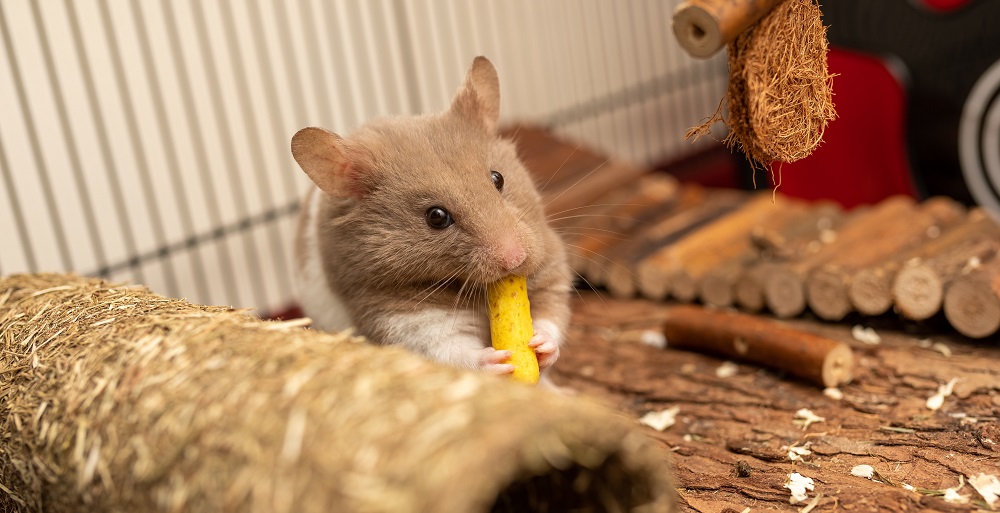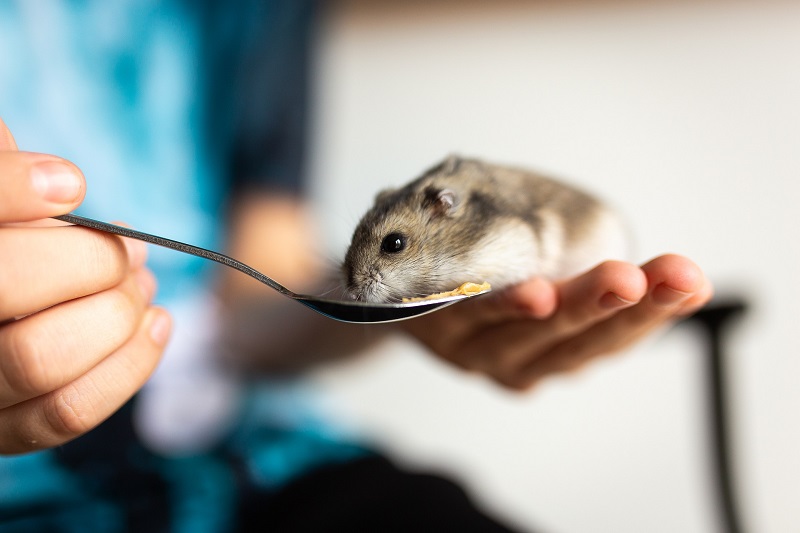Hamsters make great pets for both kids and adults – they are cute, fun, and don’t require much space. However, not all hamster species are the same.
While different hamster species have the same care requirements, they have different characteristics and personality traits.
Therefore, if you consider getting a hamster, it is vital to know a few facts about the different types of hamsters.
So let’s discuss the five domesticated hamster species you can adopt as pets: the Syrian hamster, Campbell’s Dwarf Russian hamster, Roborovski Dwarf hamster, Chinese hamster, and the Dwarf Winter White Russian hamster.
Syrian Hamster (Mesocricetus auratus)

Also called Teddy Bear or Golden Hamsters, Syrian Hamsters are the most popular hamster species to keep as a pet. Not only are they loving, but also friendly. You can easily build a strong bond with Syrian hamsters making them an ideal pet for kids.
Growing up to 7 inches in length, the Syrian hamster is larger than most hamster species kept as pets. However, they are not sociable and should be housed alone. They come in a wide range of coat colors and patterns, with golden brown and white the most popular.
They are primarily nocturnal, and thus you will rarely find them active during the day. Therefore, if you prefer a pet you can play with during the day, the Syrian hamster may not appeal to you. The best times to interact with the Syrian hamster are during the early morning and late evening.
In terms of lifespan, they live for 2-3 years on average.
Campbell’s Dwarf Russian Hamster (Phodopus campbelli)

Just like their name suggests, these hamsters are tiny (3-4 inches) and often look like little field mice. They have an average life expectancy of two years and usually have short grayish-brown fur, white fur on their belly area, and a dark stripe that runs down their backs. Campbell’s hamsters are social with their own species and can be kept in same-sex pairs or groupings if introduced to each other at a young age. However, this can be difficult, and it is not necessary for their well-being. They thrive on their own.
When well introduced to a family, this species is friendly. However, they are quick to react when frightened or threatened and can easily get injured. Therefore they are not ideal pets for kids. Make sure to provide plenty of toys, exercise wheels, and tunnels as they are very active.
Due to their small size, the Campbell’s hamster can escape from wire hamster cages. Therefore an aquarium or other solid-sided cage with a ventilated but secure top is preferable.
Like Syrian hamsters, this species is nocturnal but may wake up several times during the day.
Roborovski Dwarf Hamsters (Phodopus roborovskii)

This is another social hamster species with a good temperament, but they can be hard to tame. They are better suited to observation than handling due to their agility, size, and temperament. However, this does not mean they are not friendly when handled well but are happiest when left alone. As a result, Roborovski’s are not recommended for beginners.
The Roborovski Dwarf Hamster is among the smallest of the domesticated hamster species we have discussed (1.5-2 inches). Like other small hamster species, a well-ventilated aquarium is the preferred housing as they can escape from wire cages.
On average, these hamsters live for 2-3 years. They are social and can do well in same-sex groups as long as they are properly introduced when young. Never introduce a new Roborovski hamster to an established group. As discussed previously, while Roborovski hamsters can be housed as a group, it is not necessary for their wellbeing. The best option for any hamster is to house them alone.
For people who would like to own multiple hamsters, this species is a great choice. However, they don’t like sharing toys. Therefore, make sure to provide plenty of toys for the group.
Chinese Hamster (Cricetulus griseus)

This species of hamster can live up to three years and can grow to up to 5 inches. They have brown fur, lighter-colored underside fur, and a black stripe that runs down their back.
The species is amiable and easy to handle when consistently tamed and adequately handled from a young age. Failure to do this, they will be timid and nervous when handled.
Due to their tiny size and swift movement, you should handle them cautiously as they easily escape out of your hands. Also, stay close to the floor when handling them to avoid injuries if your pet falls.
The Chinese hamster needs a lot of attention, which makes them slightly higher maintenance. When bored, they can be destructive.
Their friendly nature means they can be kept alone, in pairs, or in same-sex groups. However, hamsters kept together may show territorial aggression towards one another. Therefore, make sure to slowly introduce them to one another when young so they can co-exist peacefully.
Keep in mind that some US states consider the Chinese hamster a pest and require a permit to own.
Dwarf Winter White Russian Hamster (Phodopus sungorus)

This species lives for around two years and is typically 3.5-4 inches in size. They are similar to Campbell’s Dwarf Russian Hamster in terms of appearance, but their dark gray fur tends to turn white in winter, hence their name.
They are quick and agile and thus not an ideal pet for kids. However, you can keep the Dwarf Winter White Hamster in same-sex groups or pairs as long you properly introduce them to each other at a young age. Do not add adults or new hamsters to an established group. Hamsters raised together may still become territorial and have to be separated as they get older.
Make sure to get an appropriate cage because their small size means they can easily escape from wire hamster cages.
Comparison of Hamster Species
| Species | Lifespan | Length | Weight | Appearance | Can be housed in same-sex groups |
| Syrian Hamster | 2-3 years | 5-7 inches | 120-200 grams | Wide range of coat colors and patterns | No |
| Campbell’s Dwarf Russian Hamster | 2 years | 3-4 inches | 30-50 grams | Wide range of coat colors and patterns. Typically short grayish-brown fur, white fur on their belly area, and a dark stripe that runs down their backs | Yes (but not necessary) |
| Roborovski Dwarf Hamsters | 2-3 years | 1.5-2 inches | 20-25 grams | White eyebrows above their eyes | Yes (but not necessary) |
| Chinese Hamster | 3 years | 3-5 inches | 30-35 grams | Typically brown fur, lighter-colored underside fur, and a black stripe that runs down their back | Yes (but not necessary) |
| Dwarf Winter White Russian Hamster | 2 years | 3.5-4 inches | 30-50 grams | Known to change their coat color to white in winter | Yes (but not necessary) |
Summary
When choosing a hamster, consider if you have the time to devote to them and whether or not you have the right environment for these small pets.
Irrespective of the hamster species you own, make sure to have enough space for them, enough time to engage with them, and the right accessories.
While several hamsters species can be housed in same-sex pairs or groups, it is unnecessary for their wellbeing and is not recommended. Housing hamsters in the same cage can result in territorial aggression and fighting, even when raised together from a very young age. The best option for any hamster is to house them alone. They are solitary animals and don’t require housing with other hamsters for their wellbeing.